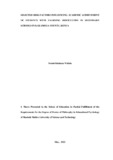| dc.description.abstract | Advocacy for inclusive education and 100 percent transition policy has increased enrolment of learners with learning difficulties in secondary schools where they encounter many challenges. The World Health Organization has, estimated that Africa’s school dropout rates of learners with learning difficulties ranges between 45- 55%. Slow learners have learning difficulties and typically attain low scores on achievement tests. Teachers regard slow learners as a bother, parents consider them a waste of funds, peers mock their efforts as they go unnoticed in large classes. Most slow learners are subject to low self-esteem and gender prejudices. This raises concern about the completion and academic achievement of slow learners whose prevalence is 10- 25% of the regular class learners. Moreover, KCSE statistics from Kakamega County indicate that a total of 55841 candidates scored grade D and below between the year 2016-2019, portentous of the presence of slow learners. The purpose of the study was to examine selected risk factors influencing academic achievement of students with learning difficulties in secondary schools in Kakamega County. Objectives were to; find out the relationship between perceived teacher, peer, parental perception and support, class size, gender and learners’ self-esteem and academic achievement of slow learners and the moderating influence of learner’s temperament. Theoretical basis of the study was attribution perception theory, Bronfenbrenner’s bio-ecological model and Vygotsky’s social cultural theory. Descriptive survey and correlational research designs were used. Target population was 36,453 form three and 37,532 four students, 1288 form three and four class teachers, and 12 sub-county Directors of Education. Multi-stage sampling techniques comprised stratified random, purposive, and saturated sampling. Sample size for slow learners was computed using Fisher’s formula. Questionnaires, interview schedules, and focus group discussion guides were used to collect data. Experts in Educational Psychology ascertained the face and content validity of the data collection instruments. Cronbach’s alpha reliability coefficient index for data collection instruments was ≥.60 which was acceptable at a .60 threshold. Data analysis comprised use of descriptive statistics; percentages, means and standard deviations and inferential statistics; Pearson’s(r), t-test, linear regression and ANOVA. Qualitative data was transcribed, analyzed and reported according to emerging themes. Findings indicated significant correlation between the factors and academic achievement of slow learners. Perceived perception and support: teacher; r =.296, peer; r =.135, parental; r =.264, gender; r =.173, self-esteem; r =.146, class size; r = -.199. However, learner’s temperament had no moderating influence. Recommendations are; teachers, parents and peers should cultivate and depict positive perception of slow learners and accord them extra support. Female slow learners be accorded more assistance. Teachers to use teaching techniques that counter negative effects of large classes. The findings are beneficial to education stakeholders in efforts to improve overall and slow learners’ academic achievement. | en_US |

